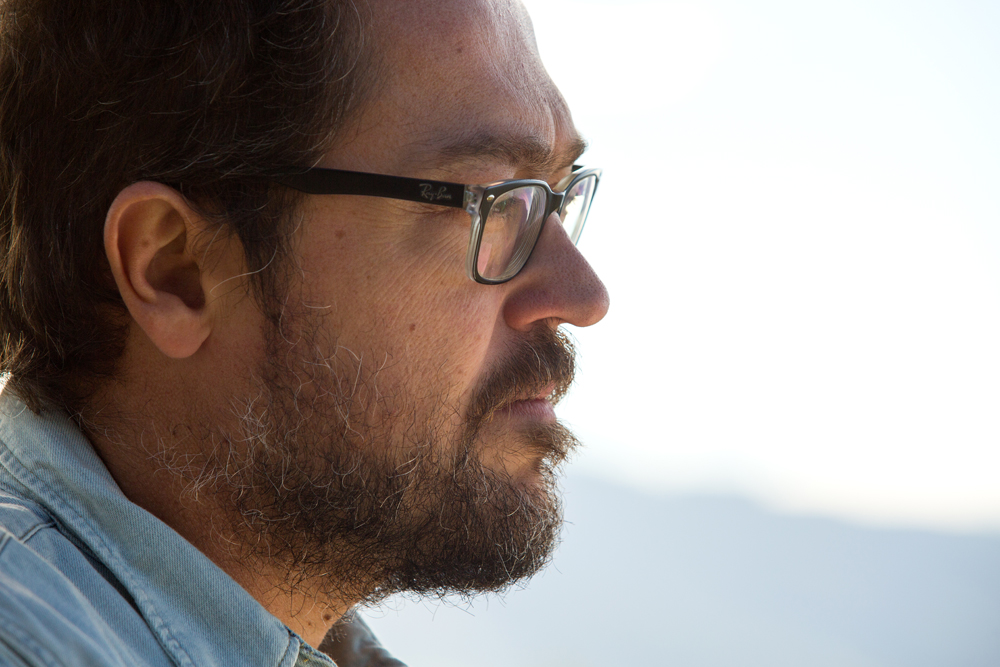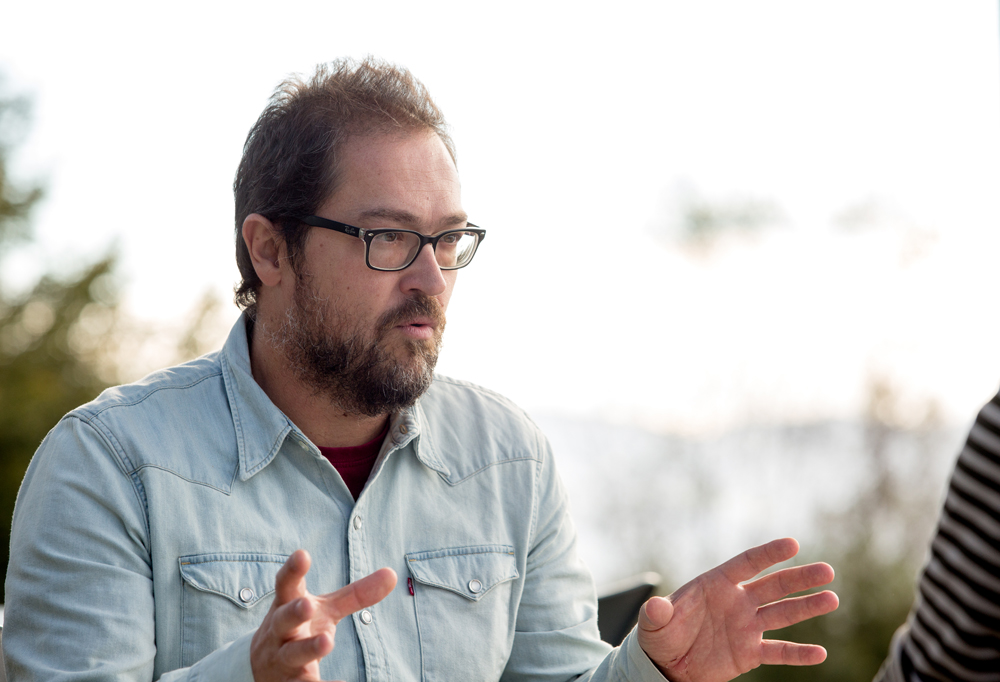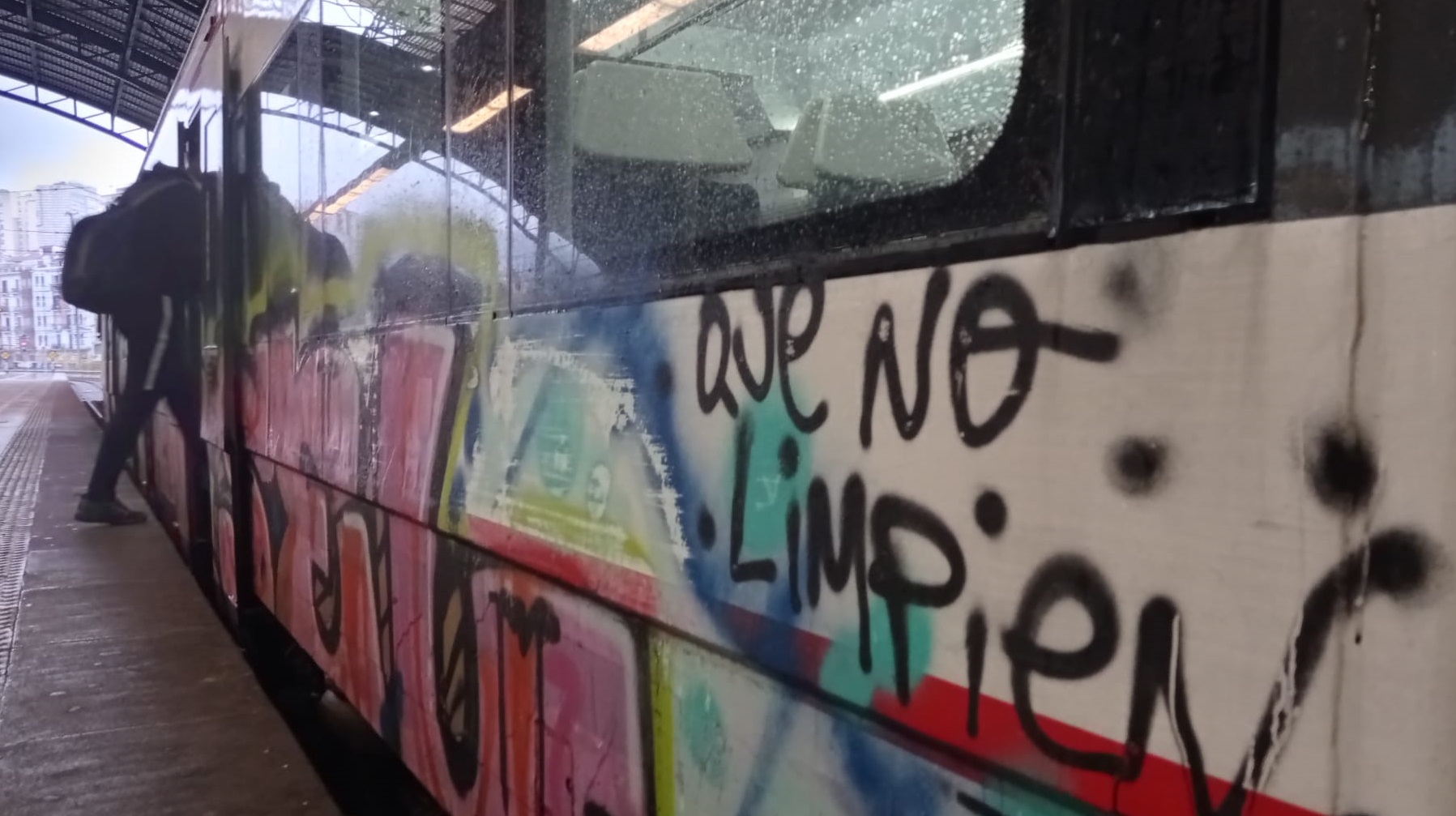"Today the same thing is worth the video of a cat than a work of art by Munch"
- He's a writer and an art critic, but first of all, he's an observer. A fine observer who adds a reading of his own to what he sees. It is able to draw as many references as arists from the work of art and give a new look at the work. In the essay book Zuloa has analyzed 23 Basque contemporary works, from which he has brought new reflections to light.

It is the morning of Monday, in which an absolute tranquillity is perceived in the Frontons of Oteiza. There's no one walking around, there's no audience. Not a kid playing the ball. For Xabier Gantzarain (Azkoitia, 1975), the giant sculptural work, located in his village, is a sample of the drift of the last era of Jorge Oteiza: “It’s not clear whether it was a project by Oteiza, or an idea by Oteiza, one thing others did. In the 90's the works of Oteiza multiplied in several localities, accepting the requests of the municipalities. They used their figure to give a new echo to the people. However, there are those who say that this uncertainty was not so unconscious, that it did so purposefully to confuse people. I’ve heard the artist Ángel Bados.” In any case, Oteiza has become the greatest figure of the 20th century for the Gantzarain. And both the quotes and the spirit of Oteiza are explained from the first chapter in his essay book Zuloa (Elkar).
The book, written with the help of the Tene Mujika scholarship, gathers 23 short sessions, each from a work of art, showing the context, relating it to life, contrasting it with memory. They all have a connection, which is works from a quarter of a century: Ibon Aranberri, Txomin Badiola, Asier Mendizabal, Itziar Okariz, Saioa olmo, Bixente Ameztoi, Jose Luis Zumeta, Jose Ramon Amondarain… The intention of Gantzarain has been to leave the abstraction and the usual tibieza of standard texts on art. “Nothing is neutral. Nor are those descriptive texts a little insignificant. By playing a silly game of words, I have tried to make a hole in that position, “I want to explain this work of art differently.”
The book begins with a text dedicated to the work Zuloa by Ibon Aranberri, and says: “Ibon Aranberri killed Oteiza.” But has the “myth of Basque origin” mentioned in the book died?
I don't think, because we really like the origin myth. Something has to be addressed, and there is always the myth of the beautiful Basque origins, which is very recurring in our imaginary: that figure of the ancestor, that ancient culture, the oldest language of Europe, and all of that we very much like, and it is repeated over and over again. I wanted to emphasize in the book that Ibon Aranberri and his generation wanted to report another time, and for that they put the generation of Oteiza to death in some way. I want to make it clear that Oteiza was killed, yes, but to keep him alive. They did a reading of the previous tradition, taking a pause, but that pause is also proposed to draw a continuum.
Isn't Oteiza still very alive, almost to an immobile shadow?
Yes, and it will remain: In the Basque Country, the most moving figure of the twentieth century is probably Oteiza. It will remain shadow, continue to influence and continue to weigh. Another thing is that that weight will change over time. When Txomin Badiola does it, it says Oteiza's reasoned catalog: we create our parents. In other words, each generation will have to make a reading, that of Oteiza, that of Badiola, that of Aranberri and that of everyone else. I believe that this is what it is all about, which is not so much taking away the importance or neglecting the previous generation, but rather fine-tuning the traces they have left: passing through the filter and saying what they have left, what is useful.
Oteiza and the Guggenheim Museum could be the two main symbols of Basque art in the last 50-60 years. Creator of the myth of Basque Origin, and on the other hand, a building that represents the art of the show…
"If there are so many people writing all the time, taking pictures... Watching who he is?"
Yes, and in addition, what the former directly criticised the latter. These are two milestones that acquire or reflect the spirit of an era. I would say that Oteiza himself is important, but perhaps more symbolic than him, Arantzazu. What it meant for the Basque culture Arantzazu, what weight the new art or sculpture had in Arantzazu. And the function of this art. And then the Guggenheim. And in it, what a function art has, what art shows up, and in addition. Arantzazu would be modernity, and the Guggenheim, in short, post-modernity.
Does this generation, worked by you in the book, lack the embodiment of what it was in society?
There's one of the starting points of my book. Txillida, Oteiza, Basterretxea, Zumeta, Mendiburu, Balerdi… We think they are incarnated, but are they really incarnated in society? Or it's kind of an idea that's stuck there. I am not very sure, and if they have been inserted more, it is likely that at that time they were used more in fields that were not art. One example: I found a 1976 calendar, pulled out by a savings bank, and every month you saw the work of an artist. You have it in the kitchen, at home. And in 1976, you don't have the Internet, you just have TV... When the references were much less, they were much more present. And in addition, their works have been used to make the Kutxa logo, to make the University of the Basque Country logo… And we have become accustomed to seeing them. In addition, as Asier Mendizabal rightly explains, we have linked to these works the idea of a collective social resurrection from the 1960s: They were in favour of a new popular movement against the dictatorship of Franco. On the contrary, with current artists it happens that the ocean of information is immense and, if the ocean is filled with images, the work of these artists appears in a small corner.
In one of the passages it says: “The artist asks an active spectator, perhaps it is asking too much, in times when there is no audience.” Why is there hardly any audience?
Boris Groys explains that Guy Debord, the philosopher who wrote La société du spectacle, was the last spectator and committed suicide: if the last spectator committed suicide, where are the spectators today? Without going that far, what you see today is that we are all creating things, making pictures, writing… and also climbing the net at all times. The question is, if there are so many people writing all the time, taking pictures -- what's there? Where is the viewer? Is there a public? In one way or another, it's a question that many people have asked in recent years.
Has that meant, to some extent, the distancing between contemporary art and society?
"The message given to us, the one sold to us, is the attitude of the tourist. Wow, wow, wow, look at this and that, but fast. Things don't weigh."
I don't know. I understand that there is a gap between art and society. But I don't know if I completely agree, because so it looks like 50 or 60 years ago you couldn't get away, and I think that's not the case either. We talk about Arantzazu, and it seems that one thing was totally accepted, protected and taken over by society, but at that time it was not, and for many people it would be a monstrous thing.
And what distance is there today?
I don't know very well. On the one hand, the public has diminished, we're all creators, we're all continuously creating, and therefore, there's no public, no public, at least one receiver like there might be before. Now we have less time, everything is instantaneous, nothing stays, things don’t have time to sediment… Everything is going on. And that's probably the biggest difference, because following things is very difficult. And in addition, the message given to us, the one sold to us, is the attitude of the tourist. Wow, wow, wow, look at this and that, but fast. Things have no weight, on the contrary, everything is very light. There's no depth, or using a term that doesn't have good fame today, there's no hierarchy.
Does art need hierarchy?
Yes, the video of a cat and an artwork from Munch is worth exactly the same as the day before. On your timeline or on the Facebook wall, they will appear next to each other or one after the other. It's all the same, and not prioritizing yourself means that: matching with a hobby thing that should tell you more things by itself. But everything is more confusing, everything is much more uniform today. Very few things are going to question my comfort and my lifestyle.
In the section of Saioa Olmo you have written: “What happens is that today there is no place, that you do not make room, that you do not find your site.” And time in space? Is there time today to dignify art?
Time is very short, we have little time. And the art system itself has fatten that trend: making a pilgrimage to the temples of art. These are the terms that the art system uses. But maybe it's more interesting to go to a temple than to a temple, look on the computer for ten minutes at an image, and see how it's built, what's built and how it works, and not be in front of the Gioconda for three seconds of the Louvre, and photograph it. The art system itself has aggravated the phenomenon of pilgrimage, and perhaps the former or the later is more important.
Isn't it in this deeply precarious society to ask too much of the street people to spend their little time contemplating art?
Of course you don't have to coerce anyone. But we demand that the average citizen, especially the man, who from very young and even very dead, tells a large part of his time to watch football, to listen to things about football, to know the injuries of soccer players… I don’t know what we can ask the individual on the street, but there is a banalization operation there. We have already mentioned hierarchy. That's what informative people do very well, those are hierarchical, quiet and insolent, and it seems that it's natural, the natural order of things. And that's what matters: art serves to ask questions about the natural order of things. If we really care what our society looks like and what it looks like, it's that you have to give more importance to art and creativity in general than you give it. Above all, from a critical point of view, to know how images are created, how they are made, what a frame means, a composition… They often seem very simple things, but...
But ...
But, as I have already heard Haizea Barcenilla on more than one occasion, there is no planning in education that teaches us how to decode images anywhere. For example, some surveys point out that children 12 and 14 years old do not identify with sexist images in some ads, indicating how things are naturalized until they become almost invisible. This is serious because, as with reading, the ability to understand is weakening.

On the other hand, there is an effort to value the work done by these current artists. He has said that he has been made very useful to read the history of recent years in Euskal Herria.
"Maybe it's more interesting than going to a temple, looking at an image on your computer for ten minutes," he added.
These artists have made an effort to read the old tradition, pause and create a new aesthetic. And I've made an effort to bring the works of these artists to another field, to the earth, to my life and to my environment, and not to make those readings that are normally made from art. Because we're used to reading, in catalogs, texts that say nothing. My challenge was to get a little wet and give me my reading. It is often said that art is not understood. But you have to unravel that misunderstanding of art.
But there are those unintelligible texts. Who has the responsibility in the art system?
There's an artist named Allam McCollum, an American, and I once read him. “The art system is invented so that no one enters.” And in a way, that's what those texts are for. We set out here what the terrain is, we define the system, and whoever accepts it will enter. The one who does not accept this is out of the system. And the same artist is sold. He does a job and knows that to expand it he needs the same system.
On the contrary, some creators, such as Koldobika Jauregi, have said that in postmodern liquid times conceptualization, mere discourse, has prevailed to the detriment of the workforce…
For me, the merit of a work of art is not in the workforce; there are not how many hours one has put in to do that work, or if he dominates the technique. For me there is no merit. Merit is for me when he knows how to say something. As a viewer, if a piece tells me something, it's valid for me, and if it doesn't tell me anything well, it doesn't have value for me, or I recognize it, but it doesn't give me that much value. The book L’Art à l’état gazeux (Art in a Gas State) is written by a certain Yves Michaud and it mentions art, tourism, globalization… Art is no longer of a specific place: there are biennials here and there, there are fairs everywhere, collectors go by helicopter… Something like this happens to us, even if we don’t go for helicopters. We are tourist spectators, and so we walk from one side to the other.
To understand the history of Euskal Herria in recent years, what has been called the Basque conflict, has art served you more than journalism?
"If we really care what our society looks like and what it looks like, it's that art should give it more importance than it is given."
Each gives me different keys and keys at different levels. For me, for example, when I saw the exhibition Bad Forms of Txomin Badiola, I was changed from the perspective of the Lumbier event [Confrontation between ETA and the Civil Guard on June 25, 1990: one civil guard died and two ethnic groups died the following morning. The official version said they had committed suicide, but the main suspicion is that they were tortured and killed by the Civil Guard.] Badiola received timber in Madrid for being “terrorist”, and in Euskal Herria also for being “distributing”. At that time he decided to begin to show in his works the imagery of the conflict and began to introduce elements that had not yet been seen. And that's something that I think is important, also as a archive.
Where is art located between the daily stories and interests of the media and this capital story they create over time?
It is a duty of art, and at the same time, a capacity, a condensation of ideas. There is a murmur, that murmur or that everyday noise of the media, and, on the contrary, I relate art to the right, to silence, not because all works of art are silent, but because they have to bring to a point the combination of many things: it can be memory, it can be the reading of another artist or of a work, it can be a subject that concerns them, but they have to lead to a single path,
Does art need prestige?
Like the other way around, even art needs a lack of prestige, and that of a de-acralization and a des… The tendency is always to explain art as something sublime and sublime. And that is precisely the problem.
But the truth is that when you try to do that, for example when very expressive paintings appear on the walls of the village, they are erased.
Yes, it was a very nice thing that happened in San Sebastian a few years ago. A painting attributed to Banksy appeared and her attitude was discussed. If it is from Banksy, it cannot be erased, because it is an asset for the people, for the City Hall, for tourism… There arose the world debate: the importance of the signing, the functioning of the system…
What do you think of the latest Banksy has done?
Well, as I have read somewhere, the buyer is very lucky, because it is going to revalue that work, which is autosuntsitu. The art system is the best exponent of capitalism. You can make the proposal more radical, the most provocative, the most transgressive, the one you want… but suddenly the system will swallow it. The art system eats anything.
“Is art fiction?” he asks in the introduction. What would you answer?
No, it's not fiction to me. Fiction / nonfiction Art goes beyond dichotomy. When Txomin Badiola puts you in front of the ends a sculpture that has a color screen with an image of the newspaper ABC and that has a black painted gold plate reminiscent of Malevich's square, and that has a wood structure… and you think there is another image… that has nothing to do with fiction. Art surpasses it. It has the ability to integrate everything, to encompass any other artistic expression. Run away from that dichotomy, it's not a fiction, but it's not a nonfiction either.
Eskultura grekoerromatarrek bere garaian zuten itxurak ez du zerikusirik gaurkoarekin. Erabilitako materiala ez zuten bistan uzten. Orain badakigu kolore biziz margotzen zituztela eta jantziak eta apaingarriak ere eransten zizkietela. Bada, Cecilie Brøns Harvard... [+]
Behin batean, gazterik, gidoi nagusia betetzea egokitu zitzaion. Elbira Zipitriaren ikasle izanak, ikastolen mugimendu berriarekin bat egin zuen. Irakasle izan zen artisau baino lehen. Gero, eskulturgile. Egun, musika jotzen du, bere gogoz eta bere buruarentzat. Eta beti, eta 35... [+]
This text comes two years later, but the calamities of drunks are like this. A surprising surprise happened in San Fermín Txikito: I met Maite Ciganda Azcarate, an art restorer and friend of a friend. That night he told me that he had been arranging two figures that could be... [+]
On Monday afternoon, I had already planned two documentaries carried out in the Basque Country. I am not particularly fond of documentaries, but Zinemaldia is often a good opportunity to set aside habits and traditions. I decided on the Pello Gutierrez Peñalba Replica a week... [+]
























